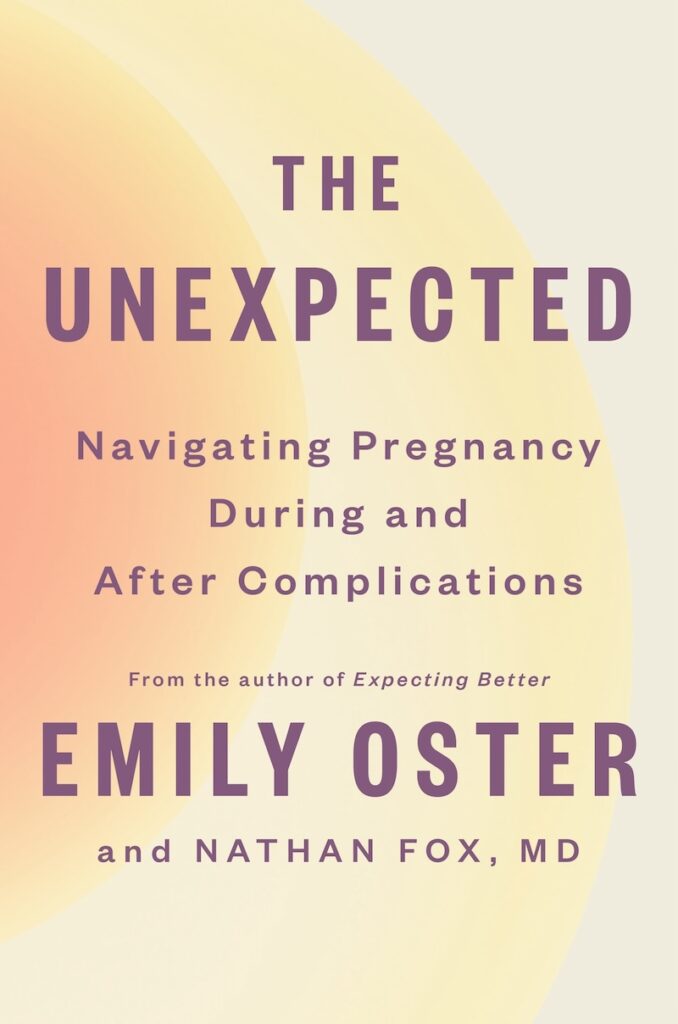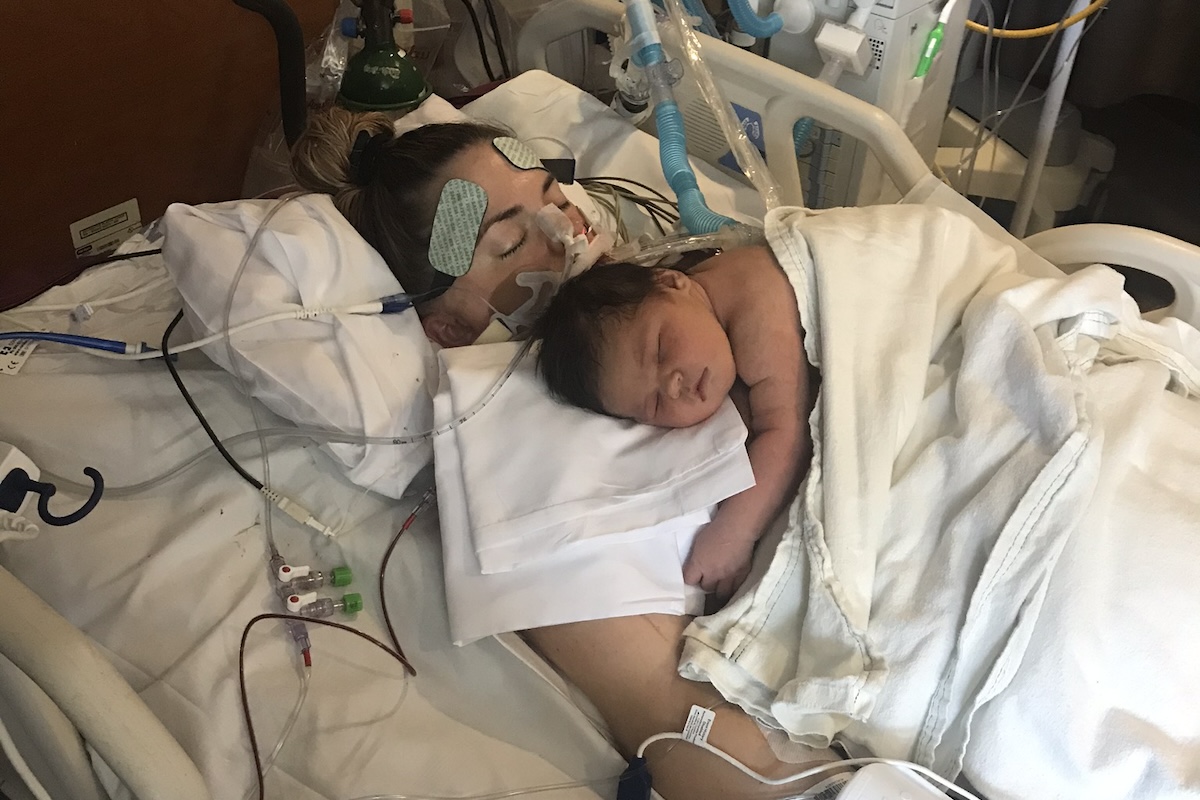My latest book, The Unexpected, co-authored with Dr. Nathan Fox is officially out. It is a guide to navigating pregnancy during and after complications. Nate and I are hopeful that it will help many of you who need it.

I want to tell you more about the book, starting with why Nate and I wrote it.
All of my other books — Expecting Better, Cribsheet, The Family Firm — came out of my own experiences. I wrote them to answer questions I had, as a pregnant woman and then as a new parent.
The Unexpected is a book not to answer my own questions but to answer yours. Specifically, to answer the thousands of questions I’ve gotten over the past decade from people whose pregnancies were more complicated than they had expected. I had a miscarriage — what is the chance it will happen again? Or My first pregnancy was complicated with hyperemesis (excessive nausea and vomiting) — should I do something different to prepare?
How many people experience pregnancy complications?
As a society, we do not talk about pregnancy and birth complications nearly enough. If you read through the table of contents for The Unexpected — preterm birth, preeclampsia, stillbirth, gestational diabetes, and others — you could be forgiven for thinking Aren’t these complications rare?
Some of them are, individually. But about half of pregnancies are complicated by one of the issues we discuss in this book. That’s 50% of pregnancies but more than 50% of pregnant women, since many people have multiple pregnancies. Despite this, when people do have these pregnancy complications, they often feel alone. Alone because we do not talk about them, and alone because resources are missing.
You are not alone.
What will you find in the book?
Although a core goal of The Unexpected is to make people feel less alone, and to bring the discussion of these complications to the fore, the actual work of the book is to answer the questions that those of you going through this need answered.
One piece of the answer is, as always, data. In the book, as we go through individual conditions, my work is to discuss the numbers. What does our best evidence say about the risk of recurrence? What evidence do we have on treatments — which might work, and how well they might work?
The data alone isn’t enough. That’s often true, and it’s especially true here, where every individual’s circumstance is a bit different, and everyone is coming from their own place physically and emotionally. This is where the second part of each chapter comes in. In those sections, Nate talks through how to approach these conversations with your doctor. The goal is to have enough understanding and enough of a script to make these talks work for you — to get the information you need and make the decisions that work for you.
My suspicion is that for readers who are navigating these issues, they will buy this book because they trust me for data, but in the end will find Nate’s sections to be the ones they really use. The book is a true partnership, and I was lucky to have such an amazing partner on it.
So that’s it! The book is out today. I’d love to say, Everyone buy my book! But in fact, I hope you do not need it. If you do, though, I’m glad that it’s there for you.
Join the conversation
There are a number of ways that I hope this book will shine a light on the experiences of people with complications in pregnancy, birth, and postpartum — starting with all of you.
In 2022, when we were outlining this project, I put out a survey on my Instagram asking women to share their stories and questions. I got thousands of responses. Some of these stories we included in The Unexpected, but there were so many more than we could put there. I want all of you to have access to them, so here they are:
I started ParentData because I want to be able to continue the conversations that start in my books. So I hope you will join in and help me keep this going far into the future.
The Unexpected: Table of Contents
Want to know more about what’s inside the book? Here’s an overview.
Part 1: Preparation
The first part of the book deals with preparation, and is intended to provide all readers with a general framework for how you might approach a pregnancy after complications. We talk through what kind of information you want to collect about your own medical history, and some decision tools that may be useful in thinking about how you want to move forward.
Chapter 1: Prepare Yourself
Engage with the question of a possible future pregnancy. Is this the right choice? Is now the right time? How can you know if you’re ready?
Chapter 2: Prepare Your Materials
Get your medical records. Talk to your doctor about your last pregnancy. You are the best keeper of your own information.
Chapter 3: Prepare Your Script
The first visit with a provider — either before another pregnancy or once pregnant — is an opportunity to set expectations and make a plan.
Part 2: Complications
The second part of the book is divided into condition-specific chapters. These are designed to be read as needed. In some cases, you may need multiple chapters. In others, only one. In each chapter, we talk through the data on recurrence and prevention and then offer a perspective on how to approach conversations with your providers about these issues.
We have tried hard to cover a large share of the major issues that arise in pregnancy, birth, and afterward. However, there will inevitably be conditions or circumstances we have missed. In these cases, we hope that going back through the first part of the book will give you a place to begin as you proceed in conversations with your own providers.
Chapters 4-5: First-Trimester Complications
Hyperemesis Gravidarum and First-Trimester Miscarriage
Chapters 6-13: Second- and Third-Trimester Complications
Second-Trimester Miscarriage, Gestational Diabetes, Preeclampsia, Fetal Growth Restriction, Preterm Birth, Cesarean Section (and VBAC), Severe Maternal Morbidity, Stillbirth
Chapters 14-16: Post-Birth Complications
Recovery Complications, Postpartum Mental Health Conditions, Breastfeeding Barriers
















Log in
In terms of recovery complications, does the book cover postpartum pain issues and inflammatory processes? I have suffered from neuropathy, tendonitis, bursitis, and inflammation that is still causing me pain a year later, including SI joint arthrosis. What shocks me is when I have spoken to other women about this, several know others who suffered something similar.